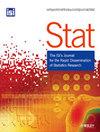图形空间采样
IF 0.8
4区 数学
Q3 STATISTICS & PROBABILITY
引用次数: 0
摘要
我们开发了滞后 Metropolis-Hastings 走法,用于根据给定的静态采样概率从简单无向图中进行采样。我们还解释了如何将该技术与设计好的图一起用于空间单位的抽样。现有的空间抽样方法主要关注样本的空间平衡,而不考虑相关的结果,与之相比,所提出的图空间抽样方法可以大大提高效率,因为图的设计可以考虑到相关结果的预期空间分布。本文章由计算机程序翻译,如有差异,请以英文原文为准。
Graph spatial sampling
We develop lagged Metropolis–Hastings walk for sampling from simple undirected graphs according to given stationary sampling probabilities. It is explained how the technique can be applied together with designed graphs for sampling of units‐in‐space. Compared with the existing spatial sampling methods, which chiefly focus on the sample spatial balance regardless of the associated outcomes of interest, the proposed graph spatial sampling method can considerably improve the efficiency because the graph can be designed to take into account the anticipated spatial distribution of the outcome of interest.
求助全文
通过发布文献求助,成功后即可免费获取论文全文。
去求助
来源期刊

Stat
Decision Sciences-Statistics, Probability and Uncertainty
CiteScore
1.10
自引率
0.00%
发文量
85
期刊介绍:
Stat is an innovative electronic journal for the rapid publication of novel and topical research results, publishing compact articles of the highest quality in all areas of statistical endeavour. Its purpose is to provide a means of rapid sharing of important new theoretical, methodological and applied research. Stat is a joint venture between the International Statistical Institute and Wiley-Blackwell.
Stat is characterised by:
• Speed - a high-quality review process that aims to reach a decision within 20 days of submission.
• Concision - a maximum article length of 10 pages of text, not including references.
• Supporting materials - inclusion of electronic supporting materials including graphs, video, software, data and images.
• Scope - addresses all areas of statistics and interdisciplinary areas.
Stat is a scientific journal for the international community of statisticians and researchers and practitioners in allied quantitative disciplines.
 求助内容:
求助内容: 应助结果提醒方式:
应助结果提醒方式:


